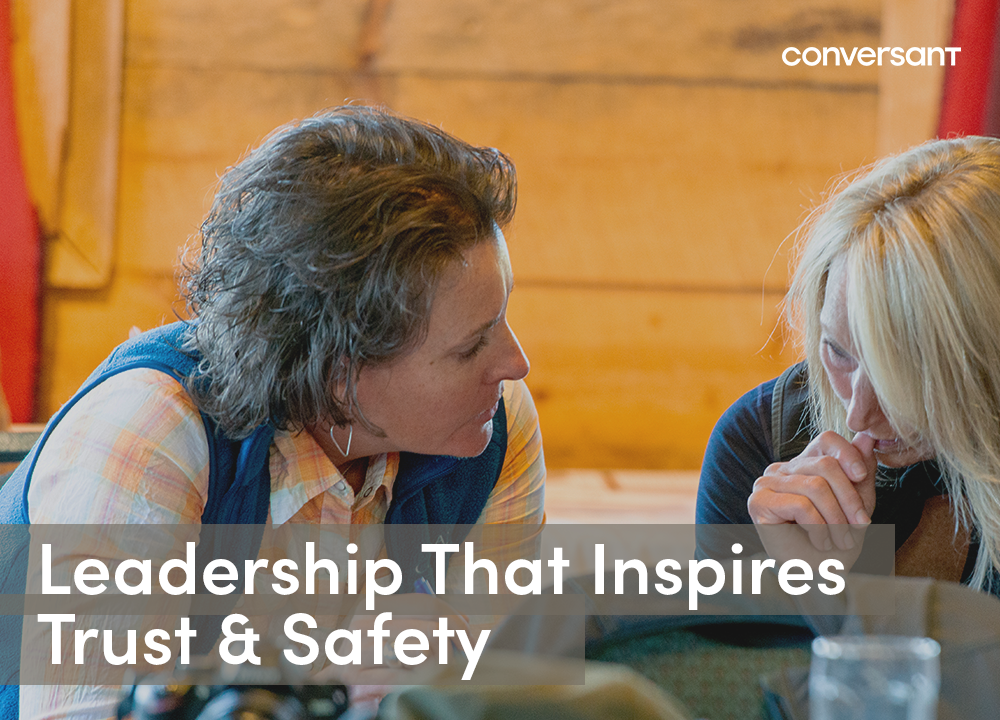Have you ever been in a conversation and had the thought, “I can’t believe that I just shared that”? Or, perhaps you leave a conversation feeling a sense of relief as you were able to say things you had been holding back. What made you feel safe enough to share so freely? At work, many of us would likely report this is a rare experience. So, what made that one different for you?
The question of how to create a greater sense of safety and candor within teams and working relationships is a common one we hear from leaders. As students of the power and joy of authentic human connection, we at Conversant know that safety and trust are products of connection.
There is a number of things we can do to build connection, but often we aren’t aware of all the ways we drive disconnection. For example, something that can quickly damage or discourage trust is a sensed threat. All of us as humans are continually gauging others and our environments for what might be threatening. Much of our attention is attending (often unconsciously) to evaluating our safety. In a work environment, this primarily applies to social situations and our psychological safety.
What Drives Disconnection
Conversationally, when we experience any sort of threat we tend to react in one of four ways: fight, flee, freeze, or appease. Fight is a strong word and may bring forth an image of raised fists or a wrestling match. In conversation, a fight is less physical and more often characterized by strong, immovable opinions and a focus on “winning.” Fleeing can include the physical act of running away, but conversationally it is often more subtle. It may show up as simple side steps or segues away from anything we are concerned might cause a negative reaction in another. Losing our ability to think or find words is often the experience of freezing. When we are overly agreeable, or “going along to get along” while sacrificing something we hold as important, that’s appeasing.
Reactivity is a normal part of human interaction. Not only normal, our reactions are some of the most important, natural, and valuable parts of being human. You might be asking, how is fighting, fleeing, freezing, or appeasing actually valuable? These reactions are natural indicators of what is important to us and what we care about. Where these reactions lose their value (or become a driver of disconnection) is when we habitually react from them instead of purposefully responding from them. The value of our reactivity is gained first by becoming aware of our reactions, and then articulating what it is we care about that’s underlying those reactions.
Increasing Self-Awareness
In my experience as a leader, my reactive tendences have often shown up as appeasement. When we appease, it is often a sign that we are afraid of not wanting to disappoint someone or fearful of what might happen if we say something different from what the other person is saying or believes. The immediate upside of appeasing may look like progress because things keep moving forward. By avoiding conflict, we seemingly stay on track. However, appeasing can often act like a delayed-release poison pill. The moment we appease, a seed of resentment has been planted. It often grows in invisible ways and the symptoms of that initial disconnected interaction show up in our systems over time. As I have learned what my appeasement was caring for, I have learned how to speak up in the context of what is important to the work being done. My job as a leader includes bringing what is important to me into the light and integrating that with what is important to both or all of us. Without this contribution, I am only bringing part of myself and my unique perspective to work. That means operating disconnected from myself and others, and denying my team and my work the potential value of my insights.
What is your primary reactive tendency? You can find out by taking our Bioreactive Styles Quiz.
Connect with Yourself First
Becoming aware of our reactive tendencies and moving towards what we care about starts with getting connected with ourselves. What are we fighting for? What are we fleeing from? What has us freeze? What is appeasing allowing us to avoid? Answering these questions in the context of what is important to us—our purposes—allows us to add the intelligence of our reactivity to our leadership rather than letting that reactivity drive our behavior and sabotage our opportunities for connection and learning.
Said another way, our ability to connect with others is governed by our ability to connect with and purposefully express ourselves. At Conversant, we work with leaders to have them become more aware of their reactive tendencies and the underlying purposes that hold a great deal of potential for value. This awareness creates more opportunities to choose differently about how we react. It’s easy to focus on the friction and conflict and to blame others for why things just aren’t working out. The truth is (and it is a hard truth for most of us), it all starts with ourselves first. Leaders need to lead by example. If they take this work on, they invite a similar level of self-responsibility and awareness across their team.
Connecting with ourselves follows similar principles as connecting with others. What do the people I work with care about? What are they worried about? Am I genuinely curious about them? About what’s important to them? About the circumstances they’re navigating? If we aren’t aware of the purposes and concerns driving our behavior, and we aren’t curious about the purposes and concerns driving others’, we seriously limit our ability to connect and overcome differences. By becoming more self-aware, we have an opportunity to look for the places where what matters to us and what matters to them overlap. That’s connection. That is where you build trust and enable disclosure. If leaders prioritized showing up to their working relationships in this way, they would be surprised by the results that are possible.
If you are a senior leader interested in connecting better with yourself and others and stepping into a new standard of leadership, please ask us about our flagship leadership development immersion: The Connected Leader: Credibility, Influence, and Impact.


